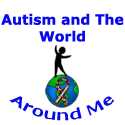History of Autism
>> Saturday, February 28, 2009
I thought that I would give you a little history of autism, and I would like to thank Patricia Lemer for her book,"Envisioning A Bright Future" Copyright 2008 by OEP Foundation, Inc. The information that I have given you has come from this book.
History of Autism
Autism comes from two Greek roots: auto (self), and ismos (condition). The word was first used by psychiatrist Eugene Bleuler in 1913. A few years earlier Theodore Hellar, a special educator in Vinenna, Austria wrote about some seemingly normal children whose behavior and learning deteriorated or was arrested in the second year of life. Heller proposed the term " dementia infantilis.
The discovery of autism is traditionally given to Leo Kanner who in the 1940's considered it to be a psychiatric disorder. In the 1960's and 1970's, Bruno Bettelheim called it childhood schizophrenia and as a result of being a "refrigerator mother". Until near the end of the 20th century Kanner's "classic" autism was the only type that was described in literature. Then, autism was rare, only one in 500,000. Patients that were diagnosed were considered unfortunate and untreatable, therefore, causing the medical establishments to ignore them and their families.
Then in the early 1990's physicians and nurses began to see more and more of these type of patients. This sparked a regression followed by a series of immunizations containing thimersol. Edward Yazbak and Congressman Dan Bruton (R-IN) have become outspoken advocates for changes in medical practice and policy because of their personal stories. Burton has held numerous Congressional hearings with government agencies, physicians, and scientists to get to the bottom of why mercury is added knowingly to vaccinations. Families began to share stories anyway they could to learn more about this epidemic.
In 1994, a meeting with one family sparked the generation of starting a registry. This meeting was the catalyst for the formation of the non-profit organization Developmental Delay Registry (DDR), which was later renamed Developmental Delay Resources. The DDR ran a statistical analysis of the responses that were completed by parents. A total of 449 children with autism spectrum diagnosis and 247 normally developing children. the results were that: 1.) children with developmental delays were 27% more likely than the unaffected kids to have had more than three ear infections. 2.) Four times as likely to have had a negative reaction to an immunization. 3.) Children who took 20 or more rounds of antibiotics were 50% more likely to be developmentally delayed than those who had not. DDR founders compiled this survey and Kelly Dorfman and Patricia Lemer saw that there were many commonalities in their early health histories: reflux, eczema, frequent ear infections, allergies, many rounds of antibiotics, yeast infections, thrush, diarrhea, constipation, immunization reactions, among others.
In the 1950's Dr. Bernard Rimland founded the Autism Research Institute. He was a psychologist and a father of an autistic son. He held "Defeat Autism Now" in January 1995. The categories included psychology, neurology, immunology, allergy, biochemistry, genetics, and gastroenterology. In February 1996, Defeat Autism Now published its first protocol co-authored by Dr. Sidney Baker, a Yale physician and former director of the Gesell Institiute and Dr. Jon Pangborn parent of autistic and chemist, as well as the President of Doctor's Date, a major medical laboratory. It has been updated five times and has grown from 40 to over 300 pages.
As early as 1867, Heinrich Stotzner, a German teacher of deaf, recognized children who did not have mental retardation, but had memories too weak to retain letters and fingers too poorly coordinated to write. James Hinshelwood who was a Scottish eye surgeon was one of the first to suggest that there was such a thing as dyslexia. In 1907, he diagnosed four brothers unlike their seven siblings with "congenital word blindness." The boys had normal intelligence, lacked visual problems, and had good visual memory except for letters and numbers, it was "evident that their defect was cerebral, probably hereditary, and caused by a defective language -related area of the brain. During the first have of the 20th century, psychiatrists, and psychologists perpetuated Hinselwoods's concept of "word blindness." Most educators attribute the term "learning difficulties" to Samuel Kirk. In the early 1960's he described children with "disorders in development of language, speech, reading, and associated communication skills" as "learning disabilities." The role of optometrist in a multi-disciplinary to learning disabilities is attributed to G.N. Getman.
In 1944, Viennese physician, Hans Asperger published a paper describing a pattern of behaviors in several young boys who had normal intelligence and language development, but who also exhibited autistic like behaviors with marked deficiencies in social and communication skills. It was not until 1994 that Asperger's Syndrome was added to the DSM-IV.
Rett's syndrome was first recognized by Andreas Rett in 1966 and affects only females. girls with Rett' s syndrome tend to have repetitive behaviors such as hand movements, prolong toe walking, body rocking, and sleep problems. In addition, Rett's syndrome demonstrates shakiness of the torso (limbs), unsteady, stiff-legged gait, breathing difficulties ( including hyperventilation, apnea, and air swallowing). Seizures, teeth grinding and difficulty chewing , retarded growth, hypo-activity, and a cognitive functioning level in the severely to profoundly mentally retarded range.
By the 1960's more and more children were entering schools as being "learning disabled." In 1969, with the passage of The Children with Specified Learning Disabilities Act, federal law finally mandated support services for students with learning disabilities. In 1975, Congress passed Public Law 94-142 or the Education for All Handicapped Children Act (EHA). It was re-enacted in 1990 as the Individuals with Disabilities Education Act (IDEA), which assures children free and adequate education to school-aged children with a dozen handicapping conditions. Another law was made in 1990 called the Americans with Disabilities Act (ADA) that extended services beyond school and into the college setting and the workplace.
Glitter Text Generator




0 special comments:
Post a Comment